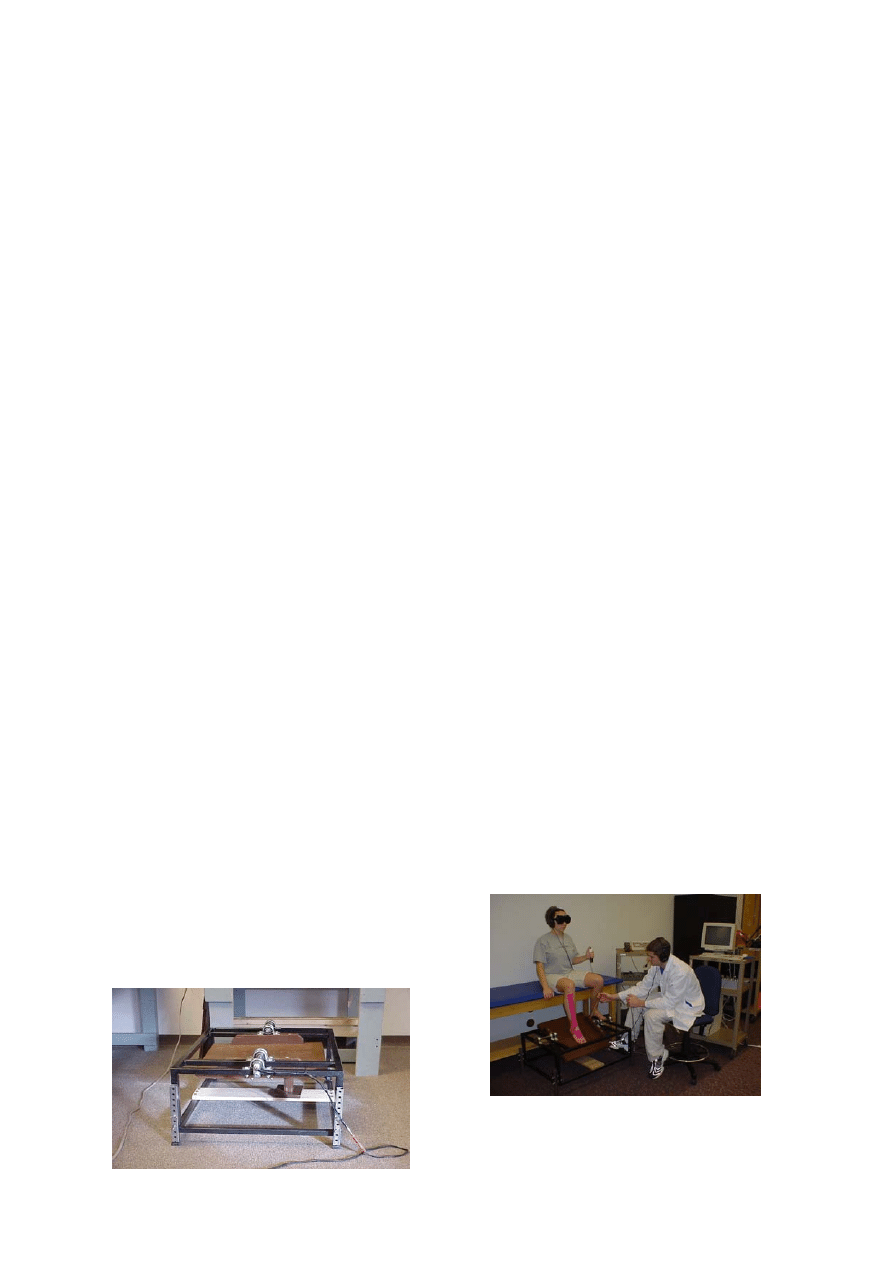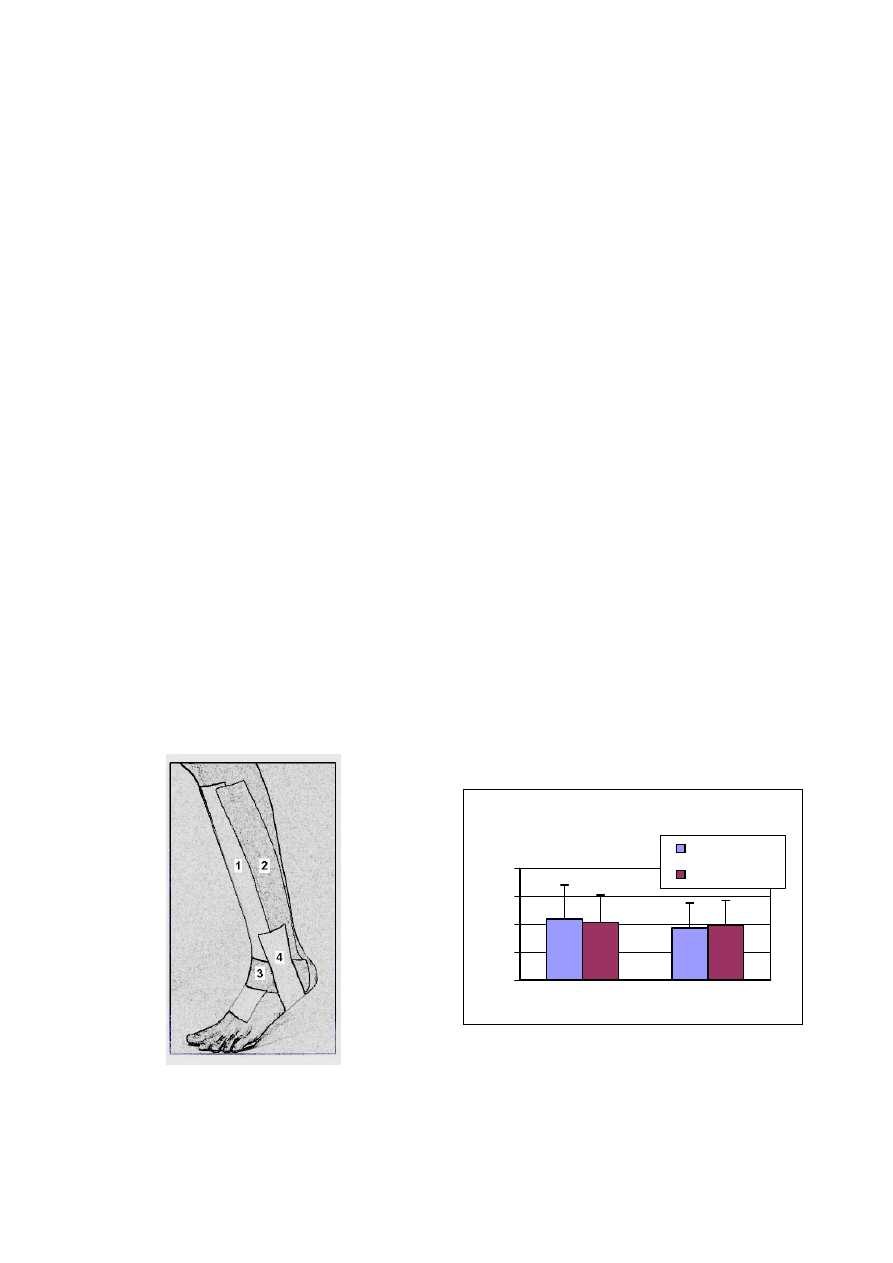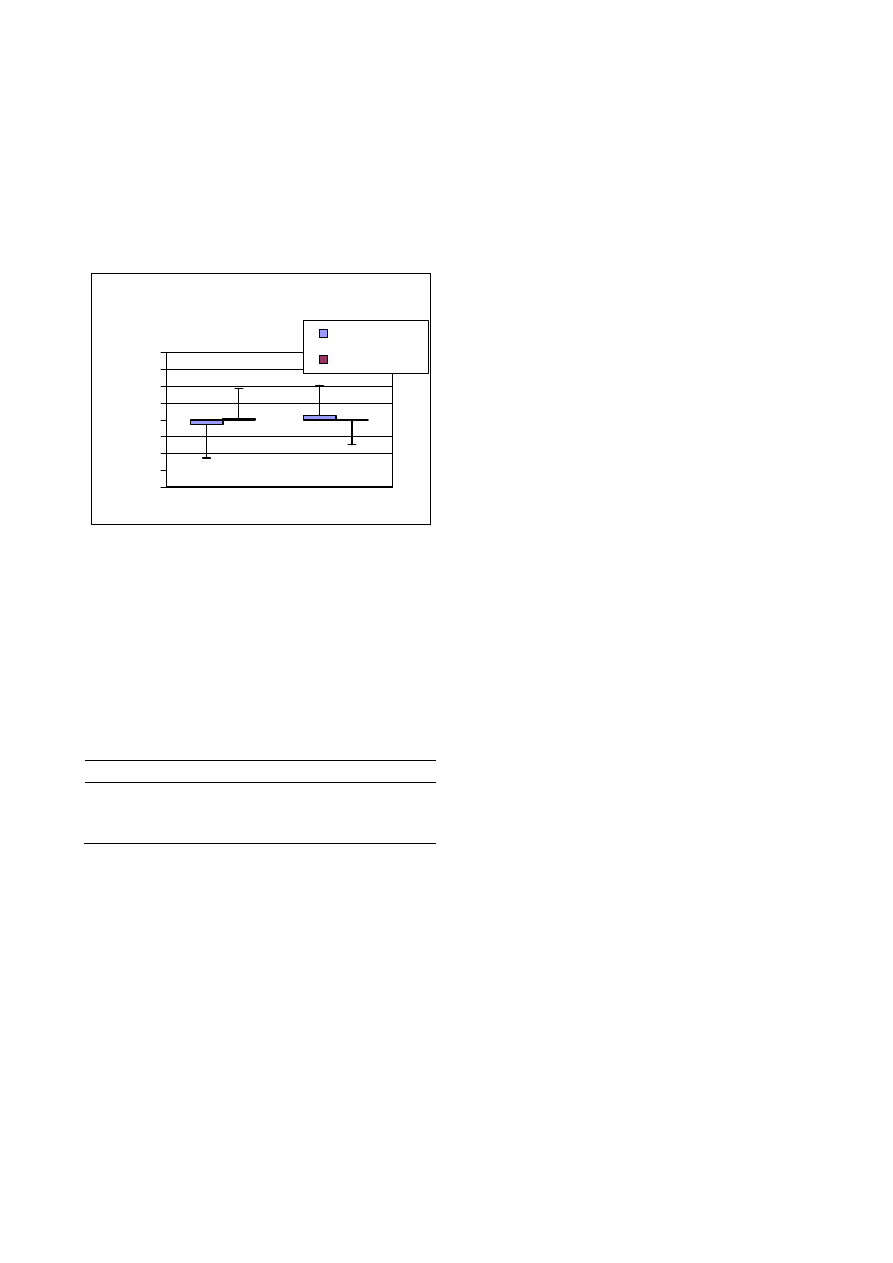
©Journal of Sports Science and Medicine (2004) 3, 1-7
http://www.jssm.org
Research article
THE EFFECTS OF KINESIO
TM
TAPING ON PROPRIOCEPTION
AT THE ANKLE
Travis Halseth
1
, John W. McChesney
2
, Mark DeBeliso
2
, Ross Vaughn
3
and Jeff
Lien
4
1
Athletic Department, University of the Pacific, USA
2
Department of Kinesiology, Boise State University, USA
3
College of Education, Boise State University, USA
4
Athletic Department, Boise State University, USA
Received: 06 September 2003 / Accepted: 21 November 2003 / Published (online): 01 March 2004
ABSTRACT
An experiment was designed to determine if Kinesio
TM
taping the anterior and lateral portion of the ankle
would enhance ankle proprioception compared to the untaped ankle. 30 subjects, 15 men, 15 women,
ages 18-30 participated in this study. Exclusion criteria: Ankle injury < 6 months prior to testing,
significant ligament laxity as determined through clinical evaluation by an ATC, or any severe foot
abnormality. Experiment utilized a single group, pretest and posttest. Plantar flexion and inversion with
20
° of plantar flexion reproduction of joint position sense (RJPS) was determined using an ankle RJPS
apparatus. Subjects were barefooted, blindfolded, and equipped with headphones playing white noise to
eliminate auditory cues. Subjects had five trials in both plantar flexion and inversion with 20
° plantar
flexion before and after application of the Kinesio
TM
tape to the anterior/lateral portion of the ankle.
Constant error and absolute error were determined from the difference between the target angle and the
trial angle produced by the subject. The treatment group (Kinesio
TM
taped subjects) showed no change in
constant and absolute error for ankle RJPS in plantar flexion and 20º of plantar flexion with inversion
when compared to the untaped results using the same motions. The application of Kinesio
TM
tape does
not appear to enhance proprioception (in terms of RJPS) in healthy individuals as determined by our
measures of RJPS at the ankle in the motions of plantar flexion and 20º of plantar flexion with inversion.
KEY WORDS: Reproduction of joint position sense, Kinesio
TM
tape, target angle
INTRODUCTION
In recent history, ankle taping has been the principal
means of preventing ankle sprains in sport (Robbins
et al., 1995). Despite the fact that ankle bracing is
growing in popularity, anecdotal evidence suggests
that ankle taping with white athletic tape is still very
popular among athletes, athletic trainers, and
physicians. However other means of ankle taping
have emerged for the treatment and prevention of
ankle injuries. Kinesio
TM
taping is a novel method of
ankle taping utilizing a specialized type of tape by
the same name. Kinesio
TM
tape differs from
traditional white athletic tape in the sense that it is
elastic and can be stretched to 140% of its original
length before being applied to the skin. It
subsequently provides a constant pulling (shear)
force to the skin over which it is applied unlike
traditional white athletic tape. The fabric of this
specialized tape is air permeable and water resistant
and can be worn for repetitive days. Kinesio
TM
tape
is currently being used immediately following injury
and during the rehabilitation process.
The proposed mechanisms by which
Kinesio
TM
tape works are different than those
underlying traditional ankle taping. Rather than

Kinesio
TM
tape and proprioception
2
being structurally supportive, like white athletic
tape, Kinesio
TM
tape is therapeutic in nature.
According to Kenzo Kase, the creator of Kinesio
TM
tape, these proposed mechanisms may include: (1)
correcting muscle function by strengthening
weakened muscles, (2) improving circulation of
blood and lymph by eliminating tissue fluid or
bleeding beneath the skin by moving the muscle, (3)
decreasing pain through neurological suppression,
and (4) repositioning subluxed joints by relieving
abnormal muscle tension, helping to return the
function of fascia and muscle (Kase et al., 1996). A
fifth mechanism has been suggested by Murray
(2001), which describes Kinesio
TM
tape causing an
increase in proprioception through increased
stimulation to cutaneous mechanoreceptors. This
proposed fifth mechanism has been examined using
our current research method.
Little is known of a possible proprioceptive
effect of Kinesio
TM
tape, however it has been
anticipated that there will be a facilitatory effect of
cutaneous mechanoreceptors as seen in studies
examining the effects of linen-backed adhesive
athletic tape (Murray, 2001). Kinesio
TM
tape may
have a similar effect on ankle proprioception due to
its aforementioned characteristics. This concept
underlies our hypotheses stating that proprioception
will be enhanced through increased cutaneous
feedback supplied from the kinesio
TM
tape.
Applying pressure to, and stretching the skin
can stimulate cutaneous mechanoreceptors. The
sense of stretching is thought to possibly signal
information of joint movement or joint position
(Grigg, 1994). Furthermore, it has been stated that
cutaneous mechanoreceptors might play a role in
detecting joint movement and position resulting
from the stretching of skin at extremes of motion,
much like joint mechanoreceptors (Riemann and
Lephart, 2002). While the exact role of cutaneous
mechanoreceptors is still under discussion, it has
become evident they can signal joint movement and
to some extent joint position (Simoneau et al., 1997).
It is important to note the exact role cutaneous
mechanoreceptors play in joint movement and
position. Several authors have attributed these
cutaneous afferents with a precise ability to convey
joint movements through skin strain patterns
(Riemann and Lephart, 2002). It was hoped that the
results of this study would add to the body of
literature on proprioception.
There have been studies documenting a
significant effect of the application of white athletic
tape to the ankle on ankle proprioception (Karlsson
and Andreasson, 1992; Robbins et al., 1995; Heit et
al., 1996; Simoneau et al., 1997). However, very
little research has been done examining the effect
alternative tape applications (such as that of
Kinesio
TM
tape) may have on increasing cutaneous
afference. Murray and Husk (2001) examined the
effect of kinesio taping on ankle proprioception.
They concluded that kinesio taping for a lateral
ankle sprain improved proprioceptive abilities in
non-weight bearing positions in the midrange of
ankle motion where ligament mechanoreceptors
were inactive.
The return of normal proprioception following
orthopedic injury has been, and should continue to
be, a major clinical rehabilitation goal (Lephart et
al., 1997). Increased somatosensory stimulation that
can be used as proprioceptive input, that is imparted
by an elastic tape such as Kinesio
TM
tape, may
enhanced an athlete's postural control system and
facilitate their earlier return to activity.
The popularity of the application of tape
during the rehabilitation process, and the need for
empirical evidence on the effect of Kinesio
TM
tape
and it's potential effect on proprioception were
compelling reasons to perform this experiment. The
purpose of this study was to determine the effect of
the application of this novel tape and specialized
taping method to an aspect of ankle proprioception,
reproduction joint position sense (RJPS). It was
hypothesized that using Kinesio
TM
taping on the
ankle/lower leg would: (1) decrease (improve) the
absolute error (AE) of RJPS when compared to the
untaped ankle in two ranges of motion: plantar
flexion (PF) and inversion at 20º of plantar flexion
(INV/PF), (2) decrease (improve) the constant error
(CE) of RJPS when compared to the untaped ankle
in PF and INV/PF, and (3) show no significant
differences in wither constant or absolute error
measures amongst gender in either range of motion.
METHODS
Thirty healthy (15 women, 15 men) subjects were
screened using a questionnaire, which asked for
details on age, gender, and medical history.
Individuals with a history of any previous serious
ankle injury or surgery, and/or those who currently
had ankle pathology, were excluded from this study.
Thirty subjects were interviewed and received a pre-
participation orthopedic ankle exam by a certified
athletic trainer (ATC) to rule out any abnormalities
(i.e. abnormal ligament laxity, congenital
deformities, neurological deficits, etc.) that may
have affected experimental data. The orthopedic
evaluation included an assessment for presence of
pain, stress tests to determine ligamentous stability,
circulatory tests, assessment of cutaneous sensation,
and tests of active, passive, and resisted ranges of
motions.
Reproduction of joint position sense (RJPS)
was measured in accordance with the subject’s

Halseth et al.
3
ability to actively recreate a randomly selected target
position. These ankle measures were taken for both
plantar flexion and inversion with 20º plantar flexion
before and after the application of Kinesio
TM
tape.
An active RJPS paradigm was selected in order to
utilize a well accepted repositioning technique
originally forwarded for the ankle by Glencross and
Thornton (1981) and then further developed by
Barrack and colleagues (1983) for RJPS at the knee.
Due to the fact that cutaneous mechanoreceptors are
stimulated during both passive and active
movements, it was assumed that the chosen
paradigm would successfully test for a treatment
effect of Kinesio
TM
tape.
Ankle position data was measured using and
instrumented platform (Figure 1) with a moveable
footplate capable of providing measures of ankle
joint position. The footplate was stabilized
throughout testing with the use of a counterbalance
system, which created an unresisted range of motion
at the talocrural joint. Attached to the platform was a
precision potentiometer (Spectrol, Type 157,
Ontario, CA), which allowed a measure of specific
angular position digitally, displaying the position to
the nearest tenth of a degree on a digital liquid
crystal display and computer data collection system
(see below). Joint repositioning trials were colleted
at a rate of 100 Hz. Laboratory tests of this apparatus
have demonstrated a repeatable range of motion
error of less that ± 0.05°. The potentiometer was
aligned with lateral aspect of the ankle to assure that
the numbers supplied were accurate readings for the
talocrural joint in the sagittal plane. During
inversion with 20° of plantar flexion condition, the
potentiometer was aligned with the center of axis of
motion of the sub-talar joint in the coronal plane
with an anterior tilt of 20°. This information was
then recorded on a computer through a 16-bit analog
to a digital board using Bioware
®
V.3.22 (Kistler
Instrument Corporation, Amherst, NY) data
collection software. A range of motion block was
used to set the talocrural neutral position (0º),
achieved when the foot is at a right angle to the tibia.
Upon completion of data collection with each
subject the RJPS apparatus was recalibrated to
assure accuracy throughout data collection.
Figure 1. Ankle joint position sense apparatus.
Procedures
To ensure RJPS was affected only by
mechanoreceptors within the ankle, subjects were
blindfolded and asked to wear headphones playing
white noise to ensure both visual and auditory cues
did not affect the results. In attempts to limit
undesired cutaneous feedback, no straps were used
to hold the subject’s foot to the platform. RJPS was
then assessed in conditions of no ankle tape (no-
tape) and kinesio taped (taped) ankle in the motions
of plantar flexion and inversion with 20º plantar
flexion. All subjects were placed in a seated position
with the foot resting on the footplate of the
apparatus.
RJPS measures were taken by passively
placing the dominant ankle to a random target angle
and asking the subject to actively reposition their
ankle to the target angle from a neutral starting
position. Target angle positions in the plantar flexion
rang varied from only 1º to 35º in attempts to
eliminate extreme ranges of plantar flexion.
Inversion with 20º of plantar flexion had an angular
position range from 1º to 10º. Five trails were given
at each range of motion with absolute and constant
error recorded for each.
Subjects were allowed to sit comfortably with
their foot on the testing apparatus. They were then
passively placed to a random target position. The
subjects were held in that position for five seconds,
asked to remember the target angle, and then
passively returned to their neutral starting position.
Subjects were then asked to actively reposition their
foot as closely to the target angle as possible.
Through headphone communication, audio mixed
over the white noise, subjects were instructed to
press an indicator button placed in their right hand,
signaling the completion of their target-reposition
task (Figure 2). Data was recorded in the Bioware
system after passive target positioning (by the
researcher), and following the subject’s signal of
completion of the target-repositioning task.
Figure 2. Subject positioning during data collection.
A cross-over design was employed with
respect to the order of the un-taped and taped
conditions. Specifically, the application of the

Kinesio
TM
tape and proprioception
4
Kinesio
TM
tape occurred after
completion of the first
10-trail assessment of RJPS in plantar flexion and
inversion with 20º of plantar flexion for 15 (or half)
of the participants. The other participants performed
the positioning tasks under the taped condition first,
followed by the un-taped condition. The participants
were randomly assigned with regard to the order of
the taped and un-taped conditions. There was a 5
minute waiting period between conditions and RJPS
assessment. All thirty subjects we assessed of a
period of one week.
Taping
Subjects were taped for a lateral ankle sprain in
accordance to Kenzo Kase’s Kinesio
TM
taping
manual (Kase et al., 1996). Taping procedures were
applied by the principal investigator (a certified
athletic trainer) to ensure consistency throughout the
study.
For taping, each subject’s foot was placed in
relaxed position while they sat on a taping table with
the ankle in slight plantar flexion. The first strip of
tape was placed from the anterior midfoot, stretched
approximately to 115-120% of its maximal length
and attached just below the anterior tibial tuberosity
over the tibialis anterior muscle. The second strip
began just above the medial malleolus and wrap
around the heel like a stirrup, attaching just lateral to
the first strip of tape. The third strip stretched across
the anterior ankle, covering both the medial and
lateral malleolus. Finally, the fourth strip originated
at the arch and stretched slightly, measuring 4-6
inches above both the medial and lateral malleolus
(Figure 3).
Figure 3. Tape strips comprising Kinesio
TM
tape job.
Numbers indicate order of application.
Data Analysis
Constant error and absolute error values were
examined by taking the difference between the target
angle and the trial angle for each subject. Constant
error examined the direction of imprecision,
measuring the number of positive or negative
degrees the actively reproduced ankle position was
from the target position. Whereas absolute error took
only the number of degrees the actively reproduced
ankle position was from the target position. In
examining possible gender differences, changes in
absolute error and constant error between un-taped
conditions and taped conditions were examined for
both plantar flexion and 20
° of plantar flexion with
inversion.
This study used a pretest-posttest design. The
independent variable was the Kinesio
TM
taping
procedure, and the dependent variable was
reproduction of joint position sense. Results were
evaluated for statistical significance (p < 0.05) using
a paired, two-tail t-test computed for both constant
and absolute error values among subjects and
independent t-tests to evaluate across genders.
RESULTS
Upon completion of data analysis, no significant
differences of absolute error between the no-tape
condition (M=2.19
° ± 1.20°) and the taped condition
(M=2.07
° ± 0.98°) were found in plantar flexion, nor
were any significant differences seen between the
no-taped condition (M=1.87
° ± 0.89°) and the taped
condition (M=1.95
° ± 0.90°) in the combined
motion of inversion with 20
° of plantar flexion
(Figure 4). These results contest our first hypotheses,
which stated Kinesio
TM
taping would decrease
(improve) the absolute error on RJPS when
compared to the untaped ankle.
Absolute Error Differences Between PF
& PF/Inversion
0
1
2
3
4
AE (Degrees)
Untaped
Kinesio taped
Plantarflexion PF/Inversion
Figure 4. Group absolute error (AE) differences
between pre and post tape conditions.
No significant difference in constant error was
shown in plantar flexion between the no-tape
condition (M = -0.28
°±2.01°) and the taped
condition (M = 0.08
°±1.77°). Furthermore, there
was no evidence of significant change in the

Halseth et al.
5
combined motion of inversion with 20
° of plantar
flexion between the no-taped condition (M =
0.24
°±1.80°) and the taped condition (M = -0.02°±
1.46
°) (Figure 5). These results discount our second
hypotheses, which stated Kinesio
TM
taping would
decrease (improve) the constant error of RJPS when
compared to the un-taped ankle.
Constant Error Differences Between PF
& PF/Inversion
-4
-3
-2
-1
0
1
2
3
4
CE (Degrees)
Untaped
Kinesio taped
Plantarflexion PF/Inversion
Figure 5. Groups constant errors (CE) differences
between pre and post kinesio tape conditions.
The data was also analyzed according to
gender. No significant (p > 0.05) differences were
detected in changes of absolute or constant error in
plantar flexion or plantar flexion with inversion
(Table 1) between genders. The third research
hypothesis was supported.
Table 1. Mean (SD) values for Error Measure
Differences (degrees, °) amongst genders.
Plantar
flexion
PF/Inversion
Men Women Men Women
AE -.15 (1.79) -.10 (.99) .40 (1.19) .23 (1.34)
CE .32 (2.38) .44 (1.46) -.11 (1.46) -.86 (1.58)
Abbreviations: AE= Absolute error, CE= Constant
error. * No significant difference between men and
women error values.
In summary, group data revealed no AE or CE
effects of Kinesio
TM
tape in any of the ranges of
motion. In gender analysis, Kinesio
TM
tape had no
effect on the changes of absolute error or constant
error amongst gender in either plantar flexion or 20
°
plantar flexion with inversion.
DISCUSSION
Results indicated no significant differences in either
absolute or constant error between the no-tape and
Kinesio
TM
taped conditions in either plantar flexion
or inversion with 20º of plantar flexion, indicating
that kinesio
TM
tape likely does not enhance
proprioception when measured by active ankle RJPS
in healthy subjects. These results do not concur with
Murray’s (2001) findings, which showed that
Kinesio
TM
tape enhanced RJPS through increases in
cutaneous stimulation received from the Kinesio
TM
tape .
It is important to note, however, since the
present study did not specifically measure changes
in cutaneous sense, that kinesio
TM
tape cannot be
ruled out as a contributor to increasing cutaneous
sense. We can only speculate on the role cutaneous
sense may or may not play in RJPS.
It may be that
kinesio
TM
tape does contribute to increasing
cutaneous feedback, however it appears that it plays
only a minimal role in RJPS. This explanation has
been forwarded by authors who have suggested
muscle and joint mechanoreceptors are the primary
contributors to proprioception (Grigg et al., 1973;
Gandevia and McCloskey, 1976; Barrack et al.,
1984; Riemann and Lephart, 2002). Conversely,
cutaneous ankle mechanoreceptors may rapidly
accommodate and not provide useful feedback
during repeated movements.
While comparing differences in CE and AE
between genders, no significant differences were
noted in either plantar flexion or inversion with 20º
plantar flexion. These findings concur with those of
the Walter’s study (2000), which showed no
significant gender differences when examining the
effects of taping on RJPS.
The findings of the present study lend support
to the concept that ankle taping has no significant
effect on ankle RJPS in plantar flexion or inversion
with 20º of plantar flexion. In Walters’ study (2000)
examining the effects of taping on RJPS, she found
no significant differences in absolute error or
constant error when comparing data before and after
the application of tape to the ankle in the ranges of
plantar flexion and plantar flexion with inversion.
The application of Kinesio
TM
tape for a lateral ankle
sprain in this study was less restrictive than her
application of the more traditionally restrictive
Gibney Basketweave, and no significant changes in
absolute error or constant error were witnesses in
either study. The present findings suggest that these
two distinctively different taping procedures are
similar in the sense that neither enhances RJPS.
With regard to methodology and its effect on
results, Heit et al., (1996) examined the effects of
bracing and taping on proprioception, noting that
both treatments significantly improved RJPS in
plantar flexion (AE). In comparison to the present
study, their un-taped condition demonstrated an AE
of 5.93°±1.91° compared to our observation of an
AE of 2.19°±1.20°. When taped, their subjects
demonstrated a significant change in AE of
3.90°±1.80° compared to our non-significant

Kinesio
TM
tape and proprioception
6
observation of an AE of 2.07°±0.98°. Heit and co-
workers’ (1996) methods utilized a Cybex II™
electronic goniometer, which required foot straps to
hold the foot in place while testing. It is possible that
these straps may have provided additional cutaneous
feedback cues to the subject during the reproduction
task, thus facilitating the subject’s ability to more
accurately reposition themselves to the previous
target position. This may offer one explanation for
the difference in their findings. Unlike the present
study design, which utilized randomly selected
target positions with each individual trial, Heit and
co-workers used predetermined target positions that
were repeated over a sequence of trials. By repeating
these predetermined target positions, it is possible
that a learning effect could have been introduced,
thus enabling the subjects to improve (decrease)
absolute error scores over the duration of their four
trial sequence. Another difference between these
studies can be seen in the positioning of the subject.
It has been suggested that gravitational positioning
may have an affect RJPS measures (Brock, 1994).
The subjects in this study were seated vertically to
eliminate any possible gravitational effects that may
have accompanied lying prone during non-weight
bearing testing, dissimilar to Heit and co-workers’
methods.
The present results also differ with the
findings of Simoneau and co-workers (1997), who
witnessed significant change in RJPS error in plantar
flexion upon application of two five inch strips of
white athletic tape applied to the lower leg. Strips of
white athletic tape were placed along the Achilles
tendon and down the anterior aspect of the ankle.
Simoneau and co-workers’ (1997) findings indicated
that proprioception, as assessed by RJPS, might have
been facilitated through the increase in cutaneous
feedback supplied by the two strips of athletic tape.
However, the findings of this study do not concur.
Again, as was the case in Heit et al.'s study,
subjects in Simoneau and co-workers’ study were
positioned to a predetermined target position for four
consecutive trials, possibly introducing a learning
effect. Finally, Simoneau placed two straps around
each calf to ensure accurate foot positioning
throughout the duration of his data collection.
However, it is reasonable to believe these straps may
have influenced cutaneous feedback in the ankle due
to their contact with the gastrocnemius and soleus
muscles (primary plantarflexors of the foot). With
this increased cutaneous feedback and possible
mechanical restriction, it is plausible that the
subjects’ ability to actively recreate target position
was affected.
CONCLUSIONS
The application of Kinesio
TM
tape does not appear to
enhance RJPS, when measured by active ankle RJPS
in healthy subjects. The hypotheses stating that
ankle taping would decrease (improve) absolute
error and constant error of RJPS were not supported
by the data.
Despite the unknown proprioceptive effects of
Kinesio
TM
tape, it has been suggested as a possible
proprioceptive facilitator in the acute phases of the
injury process (Murray, 2001). Conversely the
present results suggest that the application of
Kinesio
TM
tape to lower leg and ankle does not
provide proprioceptive enhancement as measured by
RJPS. If Kinesio
TM
taping is a mechanism that
facilitates RJPS, further investigation on subjects
suffering from acute proprioceptive loss due to
injury is needed so a possible enhancement of
proprioception can be specifically examined.
In order to fully understand the effect of
Kinesio
TM
tape on proprioception, further research
needs to be conducted on other joints, on the method
of application of Kinesio
TM
tape, and the health of
the subject to whom it is applied. Further research
may provide vital information about a possible
benefit of Kinesio
TM
taping during the acute and sub
acute phases of rehabilitation, thus facilitating earlier
return to activity participation.
ACKNOWLEDGEMENTS
Tape for this research project was donated by
Kinesio
TM
U.S.A. Corporation Limited,
Albuquerque, NM.
REFERENCES
Barrack, R., Skinner, H., Brunet, M. and Cook, S. (1984)
Joint kinesthesia in the highly trained knee.
American Journal of Sports Medicine 24, 18-20.
Barrack, R., Skinner, H., Cook, S. and Haddad, R. (1983)
Effect of articular disease and total knee
arthroplasty on knee joint-position sense. Journal
of Neurophysiology 50, 684-687.
Brock, O. (1994) Joint position sense in simulated
changed-gravity environments. Aviation, Space,
and Environmental Medicine 65, 621-626.
Gandevia, S. and McCloskey, L. (1976) Joint sense,
muscle sense, and their combination as position
sense, measured at the distal interphalangeal joint
of the middle finger. Journal of Physiology 260,
387-407.
Glencross, D. and Thornton, E. (1981) Position sense
following joint injury. The Journal of Sports
Medicine and Physical Fitness 21, 23-27.

Halseth et al.
7
Grigg, P. (1994) Peripheral neural mechanisms in
proprioception. Journal of Sport Rehabilitation 3,
2-17.
Grigg, P., Fineman,G. and Riley, L. (1973) Joint position
sense after total hip replacement. Journal of Bone
and Joint Surgery 55-A, 1016-1025.
Heit, E., Lephart, S. and Rozzi, S. (1996) The effect of
ankle bracing and taping on joint position sense in
the stable ankle. Journal of Sport Rehabilitation 5,
206-213.
Karlsson, J. and Andreasson, G. (1992) The effect of
external ankle support in chronic lateral ankle joint
instability: an electromyographic study. American
Journal of Sports Medicine 20, 257-26.
Kase, K., Tatsuyuki, H. and Tomoki, O. (1996)
Development of Kinesio
TM
tape . Kinesio
TM
Taping
Perfect Manual. Kinesio Taping Association 6-10,
117-118.
Lephart, S., Pincivero, D., Giraldo, J. and Fu, F. (1997)
The role of proprioception in the management and
rehabilitation of athletic injuries. American Journal
of Sports Medicine 25, 130-137.
Murray, H. (2001) Effects of Kinesio
TM
taping on muscle
strength after ACL-repair.
Avaliable from URL:
http://www.kinesiotaping.com. April 15, 2002, 1-3.
Murray, H. and Husk, L. (2001) Effect of Kinesio
TM
taping on proprioception in the ankle. Journal of
Orthopedic Sports Physical Therapy 31, A-37.
Riemann, B. and Lephart, S. (2002) The sensorimotor
system, Part II: The role of proprioception in motor
control and functional joint stability. Journal of
Athletic Training 37, 80-84.
Robbins, S., Waked, E. and Rappel, R. (1995) Ankle
taping improves proprioception before and after
exercise in young men. British Journal of Sports
Medicine 29, 242-247.
Simoneau, G., Degner, R., Kramper, C. and Kittleson, K.
(1997) Changes in ankle joint proprioception
resulting from strips of athletic tape applied over
the skin. Journal of Athletic Training 32, 141-147.
Walters, A. (2000) Analysis of the effects of ankle taping
on proprioception: a comparison before and after
exercise. Masters thesis, Boise State University
Library.
KEY POINTS
• Proprioception research
• Evaluation of a new taping method
• Augmentation of sensory feedback
•
Rehabilitation technique
AUTHORS BIOGRAPHY
Travis HALSETH
Employment
Asst. athletic trainer at the Univ. of the Pacific in
Stockton, California. Head athletic trainer with the
Women's basketball team at the Univ. of the Pacific
Degrees
MS, ATC
Research interests
Proprioception, Athletic Training
John W. McCHESNEY
Employment
Director of the Athletic Training/ Motor Control Lab. at
Boise State Univ. and an Assoc. Prof. in the Department
of Kinesiology.
Degrees
ATC, PhD
Research interests
Somatosensory contributions to motor performance
Mark DeBELISO
Employment
Ass. Prof. at Boise State Univ.
Degree
PhD
Research interests
Mechanics of sport movements and work tasks as well
as strength/ power training for all walks of life.
Ross VAUGHN
Employment
Interim Assoc. Dean of the College of Education at
Boise State Univ. and a Prof. in the Depart. of
Kinesiology.
Degree
PhD
Research interests
Sports biomechanics.
Jeff LIEN
Employment
Assoc. Athletic Trainer at Boise State Univ.
Degrees
MS, ATC
Research interests
Proprioception and biomechanics of the track athlete
John W. McChesney
Director Athletic Training Education Program, Athletic
Training/Motor Control Research Laboratory, Department
of Kinesiology, Boise State University, 1910 University
Drive, Boise, Idaho 83725, USA
Wyszukiwarka
Podobne podstrony:
effects of kinesio taping on the timing and ratio of vastus medialis obliquus and lateralis muscle f
Effect of Kinesio taping on muscle strength in athletes
Effect of Kinesio taping on muscle strength in athletes
Effect of magnetic field on the performance of new refrigerant mixtures
76 1075 1088 The Effect of a Nitride Layer on the Texturability of Steels for Plastic Moulds
Inhibitory effect of tea flavonoids on the ability of cell to oxidaze LDL
The Effect of DNS Delays on Worm Propagation in an IPv6 Internet
the effect of interorganizational trust on make or cooperate decisions deisentangling opportunism de
Inhibitory Effect of Dry Needling on the Spontaneous Electrical Activity Recorded from Myofascial Tr
Modeling the Effects of Timing Parameters on Virus Propagation
The Effects of Performance Monitoring on Emotional Labor and Well Being in Call Centers
Effect of drying conditions on the quality of vacuum microwave dried potato cubes
The Effects of Probiotic Supplementation on Markers of Blood Lipids, and Blood Pressure in Patients
The effects of handwriting experience on functional brain
The effects of plant flavonoids on mammalian cells implication for inflammation, heart disease, and
więcej podobnych podstron